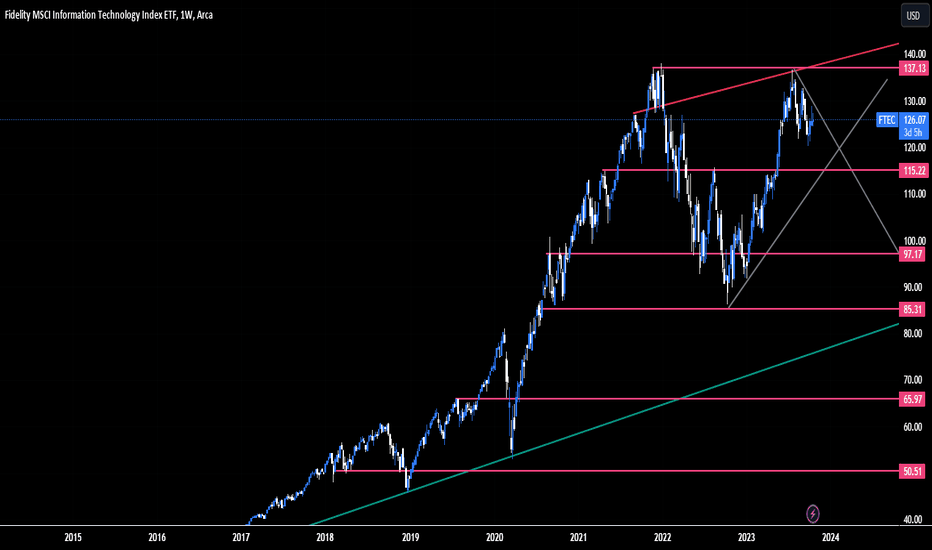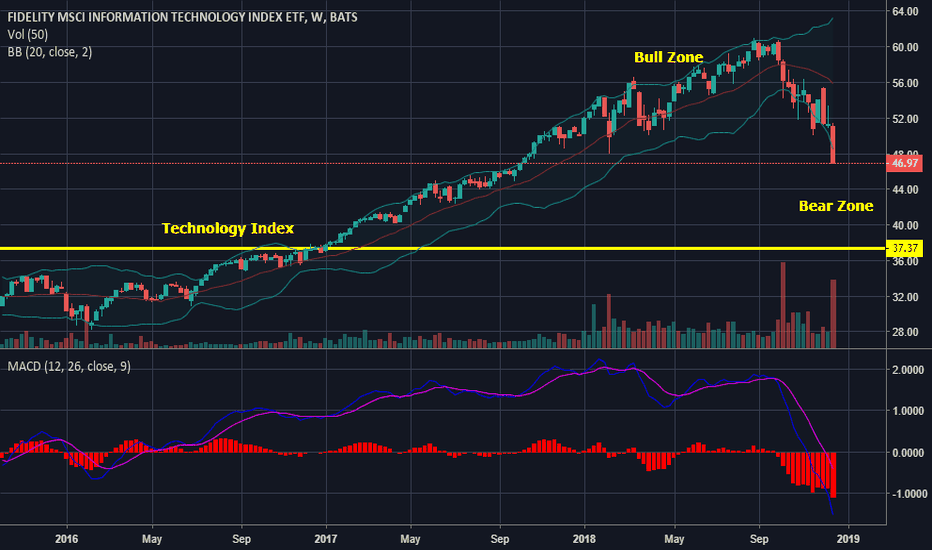SECTOR-INFORMATION TECHNOLOGYWhen looking at this chart this chart is a bit on the high side. I will be waiting for better prices to come on this one as well. A lot of the sectors seem to be on the high side at the moment, leading me to believe the overall market may see a bit of a drop before continuing higher for the long r
Key stats
About Fidelity MSCI Information Technology Index ETF
Home page
Inception date
Oct 21, 2013
Structure
Open-Ended Fund
Replication method
Physical
Dividend treatment
Distributes
Distribution tax treatment
Qualified dividends
Income tax type
Capital Gains
Max ST capital gains rate
39.60%
Max LT capital gains rate
20.00%
Primary advisor
FMR Co., Inc.
Distributor
Fidelity Distributors Corp.
FTEC provides exposure to US technology firms across all market caps by tracking the MSCI USA IMI Information Technology 25/50 Index. All selected stocks are classified as part of the Information Technology sector under GICS. The Indexs methodology applies certain investment limits for RICs under the current US Internal Revenue Code to help ensure diversification, one of which stipulates that: At the end of each quarter of its tax year no more than 25% of the value of the RIC's assets may be invested in a single issuer and the sum of the weights of all issuers representing more than 5% of the fund should not exceed 50% of the funds total assets. Moreover, the index is reviewed quarterly starting in February and reviewed semiannually in May and November. Prior to December 1, 2020, the fund tracked the MSCI USA IMI Information Technology Index.
Related funds
Classification
What's in the fund
Exposure type
Electronic Technology
Technology Services
Stock breakdown by region
Top 10 holdings
Summarizing what the indicators are suggesting.
Oscillators
Neutral
SellBuy
Strong sellStrong buy
Strong sellSellNeutralBuyStrong buy
Oscillators
Neutral
SellBuy
Strong sellStrong buy
Strong sellSellNeutralBuyStrong buy
Summary
Neutral
SellBuy
Strong sellStrong buy
Strong sellSellNeutralBuyStrong buy
Summary
Neutral
SellBuy
Strong sellStrong buy
Strong sellSellNeutralBuyStrong buy
Summary
Neutral
SellBuy
Strong sellStrong buy
Strong sellSellNeutralBuyStrong buy
Moving Averages
Neutral
SellBuy
Strong sellStrong buy
Strong sellSellNeutralBuyStrong buy
Moving Averages
Neutral
SellBuy
Strong sellStrong buy
Strong sellSellNeutralBuyStrong buy
Displays a symbol's price movements over previous years to identify recurring trends.
Frequently Asked Questions
An exchange-traded fund (ETF) is a collection of assets (stocks, bonds, commodities, etc.) that track an underlying index and can be bought on an exchange like individual stocks.
FTEC trades at 200.66 USD today, its price has fallen −2.47% in the past 24 hours. Track more dynamics on FTEC price chart.
FTEC net asset value is 200.66 today — it's risen 2.79% over the past month. NAV represents the total value of the fund's assets less liabilities and serves as a gauge of the fund's performance.
FTEC assets under management is 14.75 B USD. AUM is an important metric as it reflects the fund's size and can serve as a gauge of how successful the fund is in attracting investors, which, in its turn, can influence decision-making.
FTEC price has risen by 2.90% over the last month, and its yearly performance shows a 19.06% increase. See more dynamics on FTEC price chart.
NAV returns, another gauge of an ETF dynamics, have risen by 2.79% over the last month, showed a 18.98% increase in three-month performance and has increased by 19.46% in a year.
NAV returns, another gauge of an ETF dynamics, have risen by 2.79% over the last month, showed a 18.98% increase in three-month performance and has increased by 19.46% in a year.
FTEC fund flows account for 743.17 M USD (1 year). Many traders use this metric to get insight into investors' sentiment and evaluate whether it's time to buy or sell the fund.
Since ETFs work like an individual stock, they can be bought and sold on exchanges (e.g. NASDAQ, NYSE, EURONEXT). As it happens with stocks, you need to select a brokerage to access trading. Explore our list of available brokers to find the one to help execute your strategies. Don't forget to do your research before getting to trading. Explore ETFs metrics in our ETF screener to find a reliable opportunity.
FTEC invests in stocks. See more details in our Analysis section.
FTEC expense ratio is 0.08%. It's an important metric for helping traders understand the fund's operating costs relative to assets and how expensive it would be to hold the fund.
No, FTEC isn't leveraged, meaning it doesn't use borrowings or financial derivatives to magnify the performance of the underlying assets or index it follows.
In some ways, ETFs are safe investments, but in a broader sense, they're not safer than any other asset, so it's crucial to analyze a fund before investing. But if your research gives a vague answer, you can always refer to technical analysis.
Today, FTEC technical analysis shows the neutral rating and its 1-week rating is buy. Since market conditions are prone to changes, it's worth looking a bit further into the future — according to the 1-month rating FTEC shows the buy signal. See more of FTEC technicals for a more comprehensive analysis.
Today, FTEC technical analysis shows the neutral rating and its 1-week rating is buy. Since market conditions are prone to changes, it's worth looking a bit further into the future — according to the 1-month rating FTEC shows the buy signal. See more of FTEC technicals for a more comprehensive analysis.
Yes, FTEC pays dividends to its holders with the dividend yield of 0.45%.
FTEC trades at a premium (0.00%).
Premium/discount to NAV expresses the difference between the ETF’s price and its NAV value. A positive percentage indicates a premium, meaning the ETF trades at a higher price than the calculated NAV. Conversely, a negative percentage indicates a discount, suggesting the ETF trades at a lower price than NAV.
Premium/discount to NAV expresses the difference between the ETF’s price and its NAV value. A positive percentage indicates a premium, meaning the ETF trades at a higher price than the calculated NAV. Conversely, a negative percentage indicates a discount, suggesting the ETF trades at a lower price than NAV.
FTEC shares are issued by FMR LLC
FTEC follows the MSCI USA IMI Information Technology 25/50 Index. ETFs usually track some benchmark seeking to replicate its performance and guide asset selection and objectives.
The fund started trading on Oct 21, 2013.
The fund's management style is passive, meaning it's aiming to replicate the performance of the underlying index by holding assets in the same proportions as the index. The goal is to match the index's returns.

